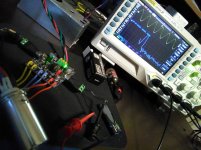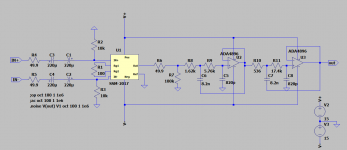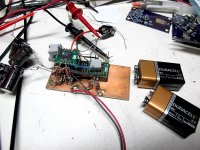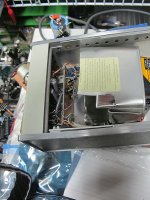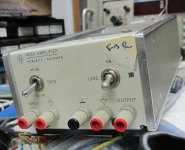Scope ground goes straight to supply ground.regarding polarity for the test scenario, Am I only interested in the '+' conductor ("+" on the cap towards the supply), or should I have one on the 0 V conductor as well ("+" away from the supply)?
You use a cap in series with the "hot/measuring" probe to block DC (which you are not interested in) but allows ripple + various noises in.
I showed how to build a safe attenuator (as in it won´t blow your Laptop Input) and use a software PC scope in:
Scope Died. Anyone Use the PC-Based Ones? | The Gear Page
That looks like it will do the business.
REW is available for Linux, it was easy to get running on my Ubuntu 18.04 machine (requires Java, though)
REW is available for Linux, it was easy to get running on my Ubuntu 18.04 machine (requires Java, though)
Am I only interested in the '+' conductor ("+" on the cap towards the supply), or should I have one on the 0 V conductor as well ("+" away from the supply)?
You always have to measure the noise 'with respect to' something. Your sound card input (if you use that) will be connected to the '+' or 'hot' of your supply but the soundcard input ground or cable screen will be connected to the psu ground.
You can't measure noise on the '-' line because that is your reference*. Voltage (noise or whatever) is in reality a voltage difference between two points but we assume that and never explicitly say it. A single point has no 'voltage'.
Jan
* it can be measured in some cases depending on configuration but that's another story.
Would there be any advantage to getting away from a line powered pc, and using a battery powered tablet of some kind?
Just for education or amusement, read this "Reading Jim Williams" blog on analog scopes.
Reading Jim Williams: Vintage scopes are better part 1
Reading Jim Williams: Vintage scopes are better part 1
Possibly however PC power supplies tend to be very good in terms of noise etc, because high speed computing is very sensitive to that kind of thing, and are unlikely to transfer "mains hum" due to being switch mode. The main benefit of a battery powered device would be ground isolation (the system ground is floating) which may be useful in some circumstances. Another way to float the input ground is using a USB sound card with a USB isolator.Would there be any advantage to getting away from a line powered pc, and using a battery powered tablet of some kind?
Member
Joined 2009
Paid Member
I read somewhere about the idea of connecting a headphone to the power rail via a small capacitor so you 'listen' to the noise level - and presumably compare with a known satisfactory supply.
Sounds cheap enough, even for a cheap-skate like me 🙄, but would think that if you can actually hear it you have a really big problem.
It does remind me of something I was thinking about, which is calibration:
Assuming I can make the Lexicon work (big IF around the existence of Linux drivers), I should calibrate using a signal source with a known amplitude. Any suggestions about things I might have kicking about the house that would do the job?
It does remind me of something I was thinking about, which is calibration:
Assuming I can make the Lexicon work (big IF around the existence of Linux drivers), I should calibrate using a signal source with a known amplitude. Any suggestions about things I might have kicking about the house that would do the job?
i was going to suggest a modification to WJ's 1995 articles on power supply testing -- he used an SSM2017, the SSM2019 which replaces it tests under 1nV/RtHz and there are similar diff amps (Tex Instruments, THAT corp) which do just as well, if not a touch better.
If you measure the noise in the 20 to 20kHz bandwidth (you'll need a good RMS detector) you'll get a very useable figure-of-merit with which to compare with other power supplies (R6 is unnecessary):
If you measure the noise in the 20 to 20kHz bandwidth (you'll need a good RMS detector) you'll get a very useable figure-of-merit with which to compare with other power supplies (R6 is unnecessary):
Attachments
Sounds cheap enough, even for a cheap-skate like me 🙄, but would think that if you can actually hear it you have a really big problem.
And if you can't hear it...
(R6 is unnecessary):
As is R7 I guess. Do you have a PCB for this Jack?
Jan
True, a soundcard should do the job with the advantage of FFT capability as outlined. Decouple with a capacitor to remove the DC component and away you go.
I'm pretty much ready to go now. Collected the Lexicon USB ADC yesterday and have made up a lead with a 1uF electrolytic inline. Hope to install the software this evening, then test tomorrow or weekend.
Is there anything else I need to be aware of, to avoid blowing the input of the Lexicon?
BR.
As is R7 I guess. Do you have a PCB for this Jack?
Jan
Dead bug style -- there are more elegant ways of doing this. One I have mounted in a HP465 amplifier carcase with gain of 20/40/60dB. It's input impedance is too low for work with tubes:
Attachments
That's a nice case of re-purposing a piece of equipment! If the designer would only know to what honors his simple case was to be elevated! ;-)
Jan
Jan
Since I mentioned Rigol , I have to report the ds1054z has changed my life.
All of the pesky bugs on my audio projects are now identified and fixed.
Parasitic intermittent oscillations, switching power supply emissions all nailed.
Ugly H5 too!
SW features now come unlocked permanently.
Thanks Rigol...
All of the pesky bugs on my audio projects are now identified and fixed.
Parasitic intermittent oscillations, switching power supply emissions all nailed.
Ugly H5 too!
SW features now come unlocked permanently.
Thanks Rigol...
If you wanna play safe, put a resistor in line (say, 1k, that shouldn't add significant amounts of noise or attenuation) and put 1n4148 or similar diodes both ways across the input. That will limit the peak voltage to around 0.6v.I'm pretty much ready to go now. Collected the Lexicon USB ADC yesterday and have made up a lead with a 1uF electrolytic inline. Hope to install the software this evening, then test tomorrow or weekend.
Is there anything else I need to be aware of, to avoid blowing the input of the Lexicon?
BR.
Excuse the crudity of my diagram, I didn't have time to draw to scale or to paint it.
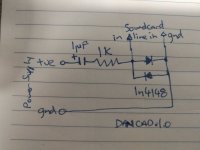
- Status
- Not open for further replies.
- Home
- Design & Build
- Equipment & Tools
- Cheap oscilloscope solution for measuring power supply noise
